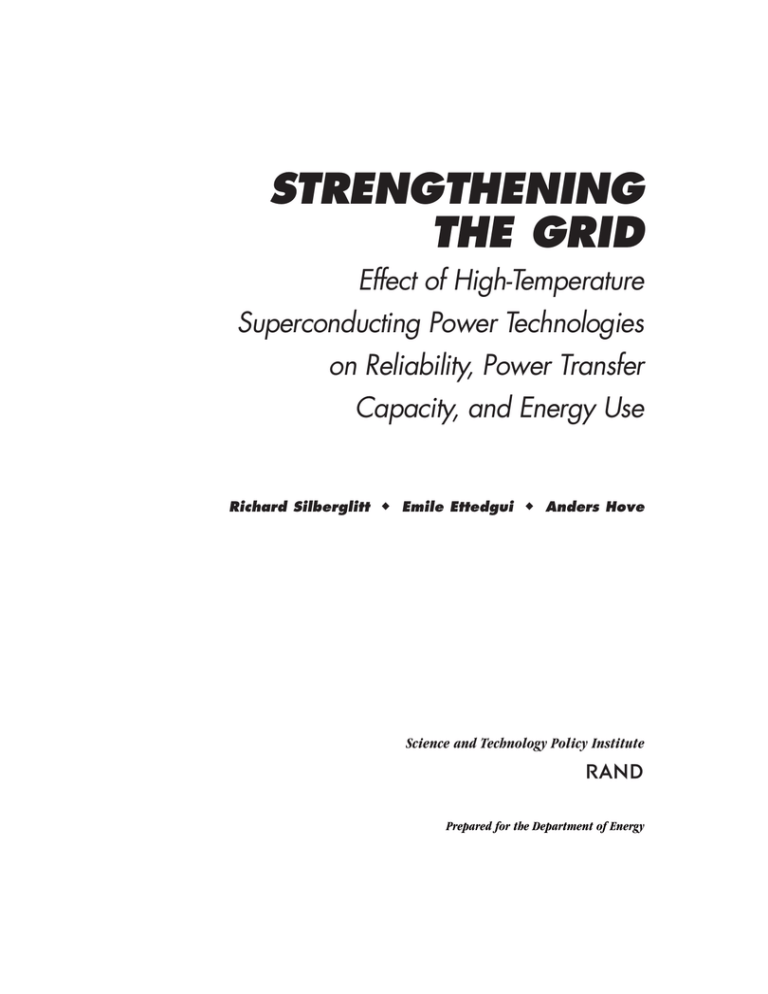
STRENGTHENING
THE GRID
Effect of High-Temperature
Superconducting Power Technologies
on Reliability, Power Transfer
Capacity, and Energy Use
Richard Silberglitt Emile Ettedgui Anders Hove
Science and Technology Policy Institute
R
Prepared for the Department of Energy
The research described in this report was conducted by RAND’s Science and
Technology Policy Institute for the Department of Energy under contract ENG9812731.
Library of Congress Cataloging-in-Publication Data
Silberglitt, R. S. (Richard S.)
Strengthening the grid : effect of high temperature superconducting (HTS) power
technologies on reliability, power transfer capacity, and energy use / Richard Silberglitt,
Emile Ettedgui, and Anders Hove.
p. cm.
Includes bibliographical references.
“MR-1531.”
ISBN 0-8330-3173-2
1. Electric power systems—Materials. 2. Electric power systems—Reliability. 3. High
temperature superconductors. I. Ettedgui, Emile. II. Hove, Anders. III.Title.
TK1005 .S496 2002
621.31—dc21
2002021398
RAND is a nonprofit institution that helps improve policy and decisionmaking
through research and analysis. RAND® is a registered trademark. RAND’s publications do not necessarily reflect the opinions or policies of its research sponsors.
Cover illustration by Stephen Bloodsworth
© Copyright 2002 RAND
All rights reserved. No part of this book may be reproduced in any form by any
electronic or mechanical means (including photocopying, recording, or information
storage and retrieval) without permission in writing from RAND.
Published 2002 by RAND
1700 Main Street, P.O. Box 2138, Santa Monica, CA 90407-2138
1200 South Hayes Street, Arlington, VA 22202-5050
201 North Craig Street, Suite 102, Pittsburgh, PA 15213
RAND URL: http://www.rand.org
To order RAND documents or to obtain additional information, contact Distribution
Services: Telephone: (310) 451-7002; Fax: (310) 451-6915; Email: order@rand.org
xi
Summary
This report evaluates the potential of high-temperature superconducting (HTS)
power technologies to address existing problems with the U.S. electric power
transmission grid, especially problems with transmission constraints. These
constraints that have resulted from the slow growth of transmission systems
relative to the growth in demand for power have played a major role in higher
electricity prices and reduced reliability in a number of areas across the United
States in recent years. Electric power components using superconducting
materials have the potential to address these transmission constraints because
they have much higher energy density than conventional power equipment,
which for transmission means added power-carrying capacity.
Superconducting power equipment requires cooling to sustain operating
temperatures hundreds of degrees below ambient temperature. Magnets based
on low-temperature superconducting (LTS) materials that require cooling with
liquid or gaseous helium have become commercial products for accelerator and
magnetic resonance imaging applications. However, the cost of cooling these LTS
materials is a substantial barrier to their use in power system components. HTS
power equipment, on the other hand, can be cooled with liquid nitrogen which is
considerably cheaper than liquid or gaseous helium, thereby reducing or
eliminating this cost barrier.
Projects are underway throughout the world to demonstrate the following
superconducting electric power components:
•
Low-loss and high-capacity power transmission cables
•
Compact, high-efficiency, and low-environmental-impact transformers
•
Storage of electricity via persistent currents in a coil (superconducting
magnetic energy storage or SMES) or persistent rotation with a magnetic
bearing (flywheel energy storage systems or FESS).
The various HTS technologies are at different stages of development: commercial
SMES, composed of magnets with LTS wire and HTS current leads, has begun to
appear in niche markets. HTS cables have been demonstrated at full scale at
distribution voltages and in lengths up to a hundred meters. HTS FESS and
transformers are also being demonstrated, but at less than full scale.
xii
Computer simulations described in the body of this report show that HTS
transmission cables produce a beneficial redistribution of power flows when
substituted for conventional cables or conductors or added to the transmission
grid. Increased power flows through the HTS cables can relieve stress on a
heavily loaded network, resulting in increased reliability and increased power
transfer capacity at the same level of reliability. This capability for downtown
Chicago is demonstrated in this report. HTS cables can also provide an alternate
transmission path at lower voltage to increase transfer capacity. This is
demonstrated for California’s Path 15 (the northern portion of the grid link
between northern and southern California). The length of the simulated HTS
cables is consistent with near-term demonstrations for Chicago, but is much
longer than what is possible in the near term for Path 15.
At what cost do HTS cables provide these benefits? Engineering comparisons of
HTS and conventional power components described in this report identify the
range of parameters, principally component utilization and cooling efficiency, for
which HTS power components may use less energy than conventional power
components. Lower energy use translates into lower operating cost. These
engineering comparisons also identify the range of HTS component (plus cooling
system) costs and electricity costs in order for the operating cost reduction to be
greater than the higher HTS component acquisition cost.
We draw the following conclusions from the data presented and analysis
described in this report:
1.
Significant transmission constraints exist in many areas of the United States.
These constraints have resulted from increased demand, increased power
transfers, and very small increases in transmission capacity over the past
several years.
2.
These transmission constraints have contributed, in some cases, to decreased
reliability and to price differentials between load areas.
3.
HTS underground cables provide an attractive retrofit option for urban areas
that have existing underground transmission circuits and wish to avoid the
expense of new excavation to increase capacity. This situation exists because
HTS cables have almost zero resistance, very small capacitance and
inductance, and high power capacity compared with conventional cables of
the same voltage. Thus, the HTS cables provide changes in power flows that
reduce stress in heavily loaded circuits, thereby increasing reliability or
power-transfer capacity and relieving transmission constraints.
4.
When operated at high utilization, HTS cables provide energy savings
benefits compared with conventional cables per unit of power delivered for a
xiii
range of HTS cable parameters consistent with existing data and engineering
estimates. However, whether or not the concomitant HTS cable operating
cost savings are greater than the increase in acquisition cost compared with
conventional cables depends on the cost of electricity.
5.
HTS cables can provide a parallel transmission path at lower voltage to
relieve high-voltage transmission constraints. The implementation of this
approach for long-distance transmission circuits will depend on the
development of periodic cooling stations and sufficient manufacturing
capacity for HTS wire.
6.
When operated at high utilization, HTS cables provide energy savings
benefits compared with conventional overhead lines per unit of power
delivered for a range of HTS cable parameters consistent with existing data
and engineering estimates. HTS cables may also provide concomitant lifecycle cost benefits for situations in which the usual cost advantage of
overhead transmission lines is mitigated by site-specific concerns such as
high land-use demands or right-of-way costs or the expense of obtaining
siting approvals or increasing power transfer capacity at higher voltage.
7.
Flywheel energy storage systems using HTS magnetic bearings are in the
demonstration stage and have the potential to achieve performance
characteristics that will make flywheels competitive with batteries in a wide
range of electricity storage applications.
8.
HTS transformers can provide increased power capacity with the same
footprint as conventional transformers and could be sited inside buildings
because they eliminate fire hazards associated with oil. If estimated HTSwire cost reductions from a new manufacturing facility are achieved and the
wire meets performance requirements, HTS transformers are projected to be
cost competitive with conventional transformers for a range of parameters
consistent with existing data and engineering estimates.
9.
Superconducting magnetic energy storage systems that use low-temperature
superconducting coils and HTS current leads have already found a niche
market for distributed reactive power support to prevent grid voltage
collapse and for maintaining power quality in manufacturing facilities.
The White House Office of Science and Technology Policy (OSTP) authored a
National Action Plan on Superconductivity Research and Development more
than a decade ago. Based upon the analysis described in this report, a 2002 action
plan for HTS power technologies might include the following recommendations:
•
The DOE-led HTS power technologies research and development (R&D)
program should continue to emphasize second-generation wire
xiv
development, with the goal of providing HTS wire meeting commercial cost
and performance targets.
•
The DOE Superconductivity Partnership Initiative should be expanded,
building on the current demonstrations that are providing operating
experience, to develop new demonstrations with operational energy or
power transfer benefits. These new demonstrations should include HTS cable
demonstrations at longer lengths and transmission voltages and
demonstrations of HTS transformers and FESS at a scale consistent with
utility substation and end-user facility needs.
•
The HTS R&D program should increase emphasis on and support for the
development of cryocoolers with multi-kilowatt capacity that can be mass
produced. These cryocoolers should have an efficiency rating greater than
today’s range of 14-20 percent of the highest possible (Carnot) efficiency at
HTS-power-component operating temperatures.
•
The HTS R&D program should increase the emphasis on and support for the
development of standards for HTS-power-component installation and
operation and increase the emphasis on and support for training of industrial
staff who will operate and maintain these installations.





